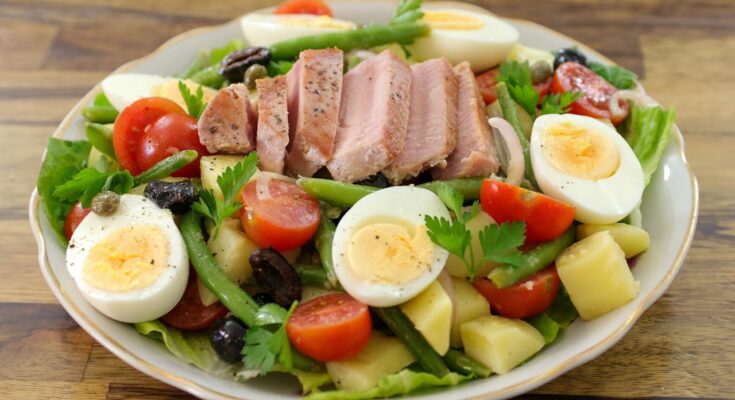Summer Salad Recipe: There’s something incredibly refreshing about biting into a chilled, crisp, and colorful summer salad when the sun is blazing. Summer is the season of ripe produce, juicy fruits, and lighter meals that don’t weigh you down. Whether you’re enjoying a picnic at the park, grilling outdoors, or just looking for a quick and healthy meal, a summer salad fits right in. Unlike heavy winter meals, summer salads are hydrating, light, and full of seasonal flavors that make your taste buds sing.
Think about it: fresh cucumbers, cherry tomatoes bursting with sweetness, avocados creamy as butter, and maybe a sprinkle of feta or a drizzle of citrus vinaigrette. It’s more than just a side dish—it’s the star of the show. Plus, summer salads are incredibly versatile. You can make them vegan, vegetarian, high-protein, or even fruity, depending on your mood and what’s in your fridge.
Salads are also perfect for meal prep. Whip up a big batch, and you’ve got lunch sorted for days. And if you’re watching your diet, they’re a low-calorie, nutrient-rich option that can be customized to meet any health goals. What’s not to love?
Health Benefits of a Fresh Summer Salad
Let’s face it: eating healthy doesn’t always feel exciting. But summer salads? They’re the game-changer. When made with the right mix of veggies, fruits, healthy fats, and lean proteins, they’re a nutritional powerhouse. The average summer salad is rich in vitamins like A, C, and K, fiber for digestion, antioxidants that fight inflammation, and good fats that keep your heart healthy.
Here’s a quick breakdown of the benefits:
- Hydration: Ingredients like cucumber, lettuce, and watermelon have high water content, keeping you cool and hydrated.
- Fiber: Helps regulate digestion and keeps you fuller for longer.
- Antioxidants: Tomatoes, berries, and leafy greens are packed with antioxidants that support your immune system.
- Healthy fats: Avocados, olive oil, and nuts provide monounsaturated fats, essential for brain and heart health.
- Low in calories, high in volume: You get a lot of food for fewer calories, which is ideal for weight management.
When you combine all these elements, you’re not just making a salad—you’re creating a dish that supports your body, boosts your energy, and still tastes incredible.
Ingredients You’ll Need
Fresh Vegetables and Greens
To make a killer summer salad, you need a solid base. This usually starts with a mix of greens and crunchy vegetables. Here’s a list of go-to veggies that work perfectly in any summer salad:
- Lettuce (Romaine, Iceberg, Butterhead, or Mixed Greens)
- Spinach or Kale (for added nutrients)
- Cucumbers (cooling and refreshing)
- Cherry Tomatoes (sweet and juicy)
- Red Onions (for a spicy kick)
- Bell Peppers (colorful and crunchy)
- Avocados (creamy and rich)
It’s best to choose organic, seasonal produce if possible. The fresher the ingredients, the better the flavor and nutritional content. Mix and match for different textures—some leafy, some crisp, some creamy.
Fruits for a Sweet and Tangy Twist
Fruit in salad? Absolutely. Fruits like strawberries, mangoes, and apples bring a burst of sweetness that balances out savory and tangy ingredients. Try adding:
- Strawberries or Blueberries
- Mangoes or Pineapple
- Apples (for crunch and tartness)
- Grapes (cut in half for easy eating)
- Pomegranate seeds (a burst of color and flavor)
These fruity additions give your salad a summer flair that’s irresistible.
Proteins and Add-Ons to Boost Flavor
Adding protein turns your salad into a complete meal. Choose from:
- Grilled Chicken
- Boiled Eggs
- Chickpeas or Black Beans
- Tofu or Tempeh
- Feta, Goat Cheese, or Parmesan
- Nuts and Seeds (like almonds, walnuts, sunflower seeds)
Each of these ingredients not only adds protein but also brings texture and richness. It’s all about making your salad satisfying enough that you don’t go hunting for snacks an hour later.
Salad Dressings: Homemade or Store-Bought?
Dressings are the soul of any salad. A good dressing ties all your ingredients together and elevates the taste. You can go store-bought for convenience, but nothing beats a homemade dressing. Here are some ideas:
Classic Vinaigrette:
- Olive oil
- Balsamic vinegar
- Dijon mustard
- Honey
- Salt & pepper
Creamy Avocado Dressing:
- Ripe avocado
- Greek yogurt
- Lemon juice
- Garlic
- Salt
Citrus Poppy Seed Dressing:
- Orange juice
- Lemon juice
- Olive oil
- Poppy seeds
- Honey
Whatever you choose, make sure it complements your ingredients without overpowering them.
Kitchen Tools Required
Essentials for Preparing Your Salad
You don’t need a fancy kitchen setup to make a great salad, but having the right tools can make the process quicker and easier. Here’s your basic toolkit:
- Salad Spinner – Dry your greens fast to avoid soggy salad.
- Sharp Chef’s Knife – Essential for chopping vegetables cleanly.
- Cutting Board – Preferably a large one to give you space to work.
- Large Salad Bowl – You need room to toss everything without spilling.
Investing in quality tools can actually make you enjoy cooking more, and you’ll find yourself making salads more often.
Tools for Mixing, Chopping, and Serving
Beyond the basics, here are a few more items that can come in handy:
- Mandoline Slicer – For perfectly thin slices of cucumber or radish.
- Tongs or Salad Servers – For tossing and serving without making a mess.
- Measuring Cups and Spoons – Useful if you’re making your own dressing.
Having the right tools isn’t just about convenience—it’s also about consistency. With them, you can recreate your perfect summer salad every single time.
Step-by-Step Guide to Making a Summer Salad
Step 1: Wash and Prep Your Ingredients
Start by washing all your produce — lettuce, cucumbers, tomatoes, bell peppers, and fruits like strawberries or mangoes. Pat them dry with a clean towel or use a salad spinner to remove excess water; this keeps your salad crisp and fresh.
Step 2: Chop the Vegetables and Fruits
Slice the veggies and fruits into bite-sized pieces. Mix colors and textures — crunchy cucumbers, juicy tomatoes, and sweet fruits make your salad vibrant and flavorful.
Step 3: Mix in Proteins and Toppings
Add grilled chicken, boiled eggs, chickpeas, or feta cheese for protein. Sprinkle nuts, seeds, or croutons for a satisfying crunch.
Step 4: Dress the Salad Right
Drizzle with olive oil, lemon juice, or balsamic vinaigrette, and season with salt and pepper.
Step 5: Toss and Chill Before Serving
Gently toss everything together, then chill for 10–15 minutes. Serve cold — a refreshing, colorful summer salad perfect for any sunny day!
Pro Tips for Making the Best Summer Salad
Balancing Flavors and Textures
Creating a salad that’s truly satisfying isn’t just about tossing a bunch of veggies in a bowl—it’s about crafting a balance of flavor, texture, and color that delights every bite.
Here’s the secret: contrast is king.
You want sweet and savory, crunchy and creamy, bold and subtle flavors working in harmony. Too much of one thing? Your salad becomes boring or overwhelming. Here’s how to master the mix:
Flavor Balancing Basics:
- Sweet: Add fruits like mango, apple, or dried cranberries.
- Salty: Use cheeses like feta or salty nuts.
- Sour: Squeeze some lemon or splash a vinegar-based dressing.
- Bitter: Greens like arugula or radicchio add a nice bite.
- Umami: Mushrooms, sun-dried tomatoes, or soy-based proteins like tofu.
Texture Play:
- Crunchy: Cucumbers, bell peppers, nuts, seeds, croutons.
- Creamy: Avocado, soft cheeses, hummus swirls.
- Juicy: Tomatoes, oranges, grapes.
- Tender: Spinach, baby kale, soft fruits.
Visually, try to use a variety of colors—not just because it looks better, but because it often means more nutrients on your plate. A colorful salad is a healthy salad.
Pro tip: Taste your salad before serving. Need a touch more acid? Add a splash of lemon. Not enough crunch? Toss in some seeds. Don’t be afraid to adjust—every salad is a work in progress.
Storing and Serving Tips
So you’ve made your perfect summer salad. But how do you keep it fresh and crisp—especially if you’re not serving it immediately?
Storing Tips:
- Keep Ingredients Separate: Store your greens, proteins, fruits, and toppings in separate containers.
- Add Dressing Last: This is non-negotiable. Only dress the salad when you’re ready to eat, or it will wilt.
- Use Paper Towels: Placing a dry paper towel over the greens before sealing the container can help absorb extra moisture.
- Airtight is Right: Always store in airtight containers to keep ingredients from drying out.
Most salads can be stored for up to 3 days, but once dressed, try to consume within 24 hours.
Serving Tips:
- Chill Before Serving: A slightly chilled salad (not cold!) is refreshing and holds shape better.
- Serve in a Large Bowl: Give it space to breathe—and toss without making a mess.
- Garnish Just Before Serving: Things like herbs, nuts, or cheese should be added at the end to maintain texture and vibrancy.
Hosting a gathering? Consider a DIY salad bar. Lay out ingredients buffet-style so guests can build their own salad. It’s interactive, fun, and caters to all dietary needs.
Variations of Summer Salads You Should Try
Mediterranean-Inspired Summer Salad
This variation is a crowd-pleaser—light, flavorful, and packed with classic Mediterranean ingredients. Imagine this: juicy cherry tomatoes, cool cucumbers, red onions, Kalamata olives, and creamy feta cheese drizzled in an herby olive oil dressing. Perfection.
Ingredients:
- Romaine lettuce or mixed greens
- Cherry tomatoes
- Sliced cucumbers
- Red onion (thinly sliced)
- Kalamata olives
- Feta cheese
- Optional: Chickpeas or grilled chicken
- Dressing: Olive oil, lemon juice, garlic, oregano
This salad is salty, tangy, and fresh—perfect as a light lunch or side dish for grilled meats. Add a few pita chips for crunch or hummus for a creamy component.
Tropical Fruit Salad
Want a taste of the islands in your bowl? Try a tropical twist. This is where sweet and refreshing dominate. Best served cold, it’s ideal for a poolside snack or light dessert.
Ingredients:
- Mango chunks
- Pineapple cubes
- Kiwi slices
- Strawberries or raspberries
- Coconut flakes (unsweetened)
- Mint leaves
- Dressing: Lime juice + a drizzle of honey
This isn’t your typical “green” salad—it’s fruity, hydrating, and full of vitamin C. Add some Greek yogurt or a scoop of cottage cheese if you want a protein punch.
High-Protein Summer Power Salad
This one’s for the gym-goers, fitness freaks, or anyone looking for a hearty meal that keeps you full. High in fiber, protein, and healthy fats, it fuels your day without the heaviness.
Ingredients:
- Baby spinach or kale
- Grilled chicken or tofu
- Hard-boiled eggs
- Quinoa or farro
- Cherry tomatoes
- Avocado
- Nuts and seeds (like pumpkin or sunflower)
- Dressing: Lemon-tahini or Greek yogurt dressing
This salad is more than a meal—it’s fuel. Perfect post-workout or as a lunch that powers you through the afternoon.
FAQs about Summer Salad Recipe
Can I make a summer salad ahead of time?
Yes! But with a few precautions. Prep your veggies and store them separately from delicate greens and dressing. Only mix everything together and add dressing right before serving to avoid sogginess. For meal prepping, consider making “jar salads” with layers—dressing at the bottom, sturdy veggies next, and greens on top.
What proteins work best in a summer salad?
Great proteins for summer salads include grilled chicken, hard-boiled eggs, shrimp, tuna, chickpeas, lentils, tofu, and even quinoa. These ingredients add substance and satiety without making the salad heavy. Choose grilled or baked options over fried to keep things light and healthy.
How do I keep my salad from getting soggy?
Dry everything thoroughly—especially leafy greens—using a salad spinner or kitchen towel. Store dressing separately and only toss the salad right before serving. Avoid water-heavy fruits or vegetables unless you’re serving immediately.
What’s the best dressing for a summer salad?
The best dressing depends on your ingredients, but lighter vinaigrettes made with citrus, vinegar, or yogurt bases tend to work best. Popular summer dressings include lemon-honey vinaigrette, balsamic glaze, and creamy avocado-lime dressing. Avoid heavy cream-based dressings if you want to keep it refreshing.
Can I add pasta or grains to a summer salad?
Absolutely. Pasta, quinoa, farro, or couscous can turn a basic salad into a hearty meal. Just make sure they’re cooked and cooled before mixing in. They absorb flavors beautifully and add an extra layer of texture and fiber.
Conclusion
Remember: freshness is key, balance is everything, and creativity makes the difference. Don’t be afraid to experiment. Try new dressings, throw in a handful of something unexpected, and most of all—enjoy the process. Eating healthy shouldn’t feel like a chore, and with these summer salad ideas, it never will.
Next time the sun’s blazing and you’re hungry for something light, crisp, and colorful, you’ll know exactly what to do. Grab those greens, pick your favorite toppings, whip up a killer dressing, and dive into a bowl full of summer.



